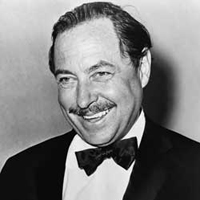Dramatic Technique in The Glass Menagerie
Tennessee Williams has given a purely unique touch to The Glass Menagerie by not dividing his play into Acts. Unlike other classical plays and the nineteenth century plays The Glass Menagerie has not been divided into Acts. It is a collection of seven scenes. Though the play is a collection of scenes, these scenes are brought in a sense of tight unity.

Tennessee Williams (1911-1983)
It seems Tennessee Williams had been preoccupied with the pressing need to capture the unity of action. He aims at keeping intact the sense of smooth continuity of action. His motive behind not dividing the dramatic action into acts is to keep intact the uninterrupted unfolding of the action. There is another reason also. The Glass Menagerie is an enactment of moments in Tom's memory. While enacting moments in memory it is very difficult to divide the action. The content of memory is not subject to the structural division. The substance of memory gets unfolded in an uninterrupted and unperturbed manner. That is why the dramatic action remained undivided and unbroken. The technique of avoiding the principle of dividing the action into Acts had been effectively handled by Tennessee Williams in The Glass Menagerie.
The second effective technique handled by Tennessee Williams is the technique of the psychological realism. This technique helped the playwright to give particular attention to the organization of conversation. Williams so designed the dialogue in The Glass Menagerie that it reveals character. The nature of the characters of this play gets revealed through the snatches of the conversation. If we read the play with an analytical insight we come across those elements, which illustrate that some characters have still been immature. The clumsiness of some characters, the awkwardness of their get revealed from the further progression of dialogue. In this play Amanda Wingfield constantly admonishes her son Tom to munch his food properly before swallowing it. From this frequent admonishment of Amanda to Tom, we guess whether Tom is suffering from an unknown imbecility. Amanda constantly tells Laura to feel as though nothing had happened to her, as though she is physically spotless. From this advice of Amanda to Laura, we come to comprehend that Laura was afflicted with a deeply embedded flaw in becoming extrovert.
Due to the technique of the psychological realism Williams paid close attention to the art of depicting characters' psychological reactions. Towards Amanda's much-more-repeated-admonishment (Rise and Shine, don't smoke, and don't go to a movie) Tom Wingfield reacted violently. He called his mother witch. From this sort of angry irritation made by Tom, we catch a glimpse of what kind of psychological makeup Tom Wingfield has. Once we trace the psychological makeup of the psychological realism.
The third crucial technique Williams adopted is the technique of using the same character of the play as the narrator. Because this play is a memory play, it is customary of the playwright to make one of the characters the narrator. Because The Glass Menagerie is a modernist play, which defies the illusionist conventions, it is pretty imperative to include one commentator. To insert a brief hint of commentary upon the conventional theatre personnel is to declare the innovative and the distinctive dimension of the play. In the brief introduction Tom remarks:
''Yes, I have tricks in my pockets, I have things up my slave. But I am the opposite of a stage magician. He gives you illusion that has the appearance of truth. I give you truth in the pleasant disguise of illusion.''
The fourth virile technique handled by Williams in The Glass Menagerie is the technique of using music, lighting, legend, screen play and images. These various elements help to embody the alive and fresh moment of the past in the memory of the narrator. To bring into the prominence the pathos and plight of characters Williams introduced legends and images. For instance, when Laura was bringing out her past life in school from the chamber-box of her memory, the image blues-rose came. When Amanda was recklessly persuading Tom to stop hankering for a movie and adventure, the legend of Jolly Roger came. In this technique helped the playwright to catch the emotional intensity of the present by virtue of legend and screenplay.
Last but not the least, Tennessee Williams made use of an indirect technique of ending the play as though a new play in the life of character is going to begin. The play opens with the narrative commentary delivered by Tom Wingfield. It ends with the interior monologue of the frequently frustrated Tom Wingfield. Thus, the play is given a sense of closure and completion from the view point of Tom Wingfield. Thus, its structural compression is tantamount to the structure of Tom's painful moment in his painful memory.
The Glass Menagerie Study Center
Nature of illusion in The Glass Menagerie
Tom as a Representative of the 20th Century Man
Laura as a Romantic Superwoman in The Glass Menagerie
The Glass Menagerie Study Center
Introduction of The Glass Menagerie
Summary of The Glass Menagerie
Symbolism in The Glass Menagerie
Sublimating Animal Drives into Aesthetics
Style of Williams in The Glass Menagerie
Biography of Tennessee Williams
 |
bachelorandmaster.com |